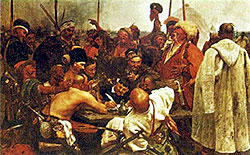|
Add URL Our Partners |
Ukraine History
 In ancient times a major part of present-day Ukraine was inhabited by the Scythians, who were later displaced by the Sarmatians. Early in the Christian era, a series of invaders (Goths, Huns, Avars) overran the Ukrainian steppes, and in the 7th century the Khazars included much of Ukraine in their empire. The Ukrainians themselves can be traced to Neolithic agricultural tribes in the Dnieper and Dniester valleys.
In ancient times a major part of present-day Ukraine was inhabited by the Scythians, who were later displaced by the Sarmatians. Early in the Christian era, a series of invaders (Goths, Huns, Avars) overran the Ukrainian steppes, and in the 7th century the Khazars included much of Ukraine in their empire. The Ukrainians themselves can be traced to Neolithic agricultural tribes in the Dnieper and Dniester valleys.
In the 9th century, a Varangian dynasty from Scandinavia established itself at Kiev. The Varangians united the Slavs in the powerful Kievan Rus, which stretched from the Volga west to the Danube and south to the Baltic. The land and people of Ukraine formed the core of Kievan Rus. In 988, the Kievan Rus leader Volodymyr accepted Christianity from Constantinople.
In the mid-14th century Lithuania began to expand eastward and southward, supplanting the Tatars in Ukraine. The dynastic union between Poland and Lithuania in 1386 also opened Ukraine to Polish expansion and finally Ukraine came under Polish rule.
The term Ukraine, which may be translated as "at the border" or "borderland," came into general usage in the 16th century. The harsh conditions of Polish rule led many Ukrainians to flee serfdom and religious persecution by escaping beyond the area of the lower Dnieper rapids. There they established a military order called the Zaporizhzhya Sich ("clearing beyond the rapids"). These fugitives became known as Cossacks or Kozaks, an adaptation of the Turkic word kazak, meaning "outlaw" or "adventurer." In 1648 the Cossacks, led by Hetman Bohdan Chmielnicki, successfully waged a revolution against Polish domination.
Ukraine, however, was too weak to stand alone, and in 1654 Chmielnicki recognized the suzerainty of Moscow in the Treaty of Pereyaslavl. By the terms of the treaty, Ukraine was to be largely independent; but Russia soon began to encroach upon its rights. Through a treaty with Poland in 1658, Ukraine attempted to throw off Russian protection. The Russo-Polish war ended in 1667. Russia obtained left-bank Ukraine, east of the Dnieper River and including Kiev; Poland retained right-bank Ukraine.
Hetman Ivan Mazepa, presiding over a diminished Cossack state, sought once again to free Ukraine from Russian domination; he thus joined Sweden against Russia in the Northern War, but their defeat at Poltava by Czar Peter I in 1709 sealed the fate of Ukraine. Mazepa's fall crushed the last hopes for Ukrainian independence and further curtailed Ukrainian autonomy.
Despite a Russian ban on use of the Ukrainian language in the schools and in publications, a movement for Ukrainian national and cultural revival blossomed in the late 19th century. After the Bolsheviks' revolution the Ukraine descended into anarchy and after prolonged fighting involving Russia, Poland and various Ukrainian political and ethnic factions, Poland retained portions of western Ukraine and the Soviets got the rest. Ukraine officially became part of the USSR in 1922.
During the purges of 1937-39, millions of Ukrainians were either executed or sent to Soviet labour camps. WWII brought further devastation and death, with 6 million perishing in the fighting between the Red Army and the German forces.
In 1986 one of the reactors of the Chernobyl nuclear power station exploded, contaminating a wide area of Ukraine.
The Ukrainian parliament passed a declaration of sovereignty in July, 1990, and in August, 1991, declared Ukraine independent of the Soviet Union. Ukraine became a charter member of the Commonwealth of Independent States (CIS) in December, 1991.

|
Kiev Travel Guide7320 N Dreamy Draw DrivePhoenix, Arizona 85020 (602) 553-8178 FAX (602) 468-1119 Contact Us |
|
|
||